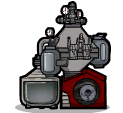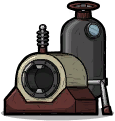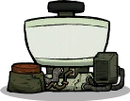Glass Forge
Jump to navigation
Jump to search
Glass Forge is a Refinement Building that refines Sand into Molten Glass. Created Molten Glass is released through its Liquid Output with a temperature of 1941.85 °C3527.33 °F, and should be cooled by other means. Recipes take a base time of 40s to complete and benefit from high Machinery.
Glass Forge is a unique building in that it can be used to reheat cooling magma.
Tips
- Molten Glass has a freezing point of 1126 °C and will solidify into Glass almost instantly when exposed to normal temperatures. If this happens inside a liquid pipe, it will cause "cold damage" and break the pipe. To avoid this, use Insulated Liquid Pipe for the Glass Forge output and make the pipe as short as possible.
- The bottom middle tile of the Forge must also be kept insulated to avoid pipe cracking. For the purposes of heat transfer, the molten liquid inside the building is considered to be on that tile. If there is sufficient thermal conductivity then the glass can cool to its freezing temperature inside the forge; it will then freeze and crack the pipe as soon as it exits.
- In particular, even the smallest amount of water on the ground will cause pipes to burst. Mop up your workspace!
- It is usually sufficient to drop the Molten Glass out of a liquid vent onto the ground. Although the temperature is very high, the amount of heat is not. The high temperature delta will cause the heat to dissipate quickly but the low mass and low Specific Heat Capacity mean that the total effect is comparable to other industrial machines. Some care should be taken - it's probably a bad idea to have Lead (melting point 327.5 °C) on the same tile as the cooling Glass - but generally the heat can be treated like any other source.
- Dropping the molten glass into water is an effective way to freeze it.


































